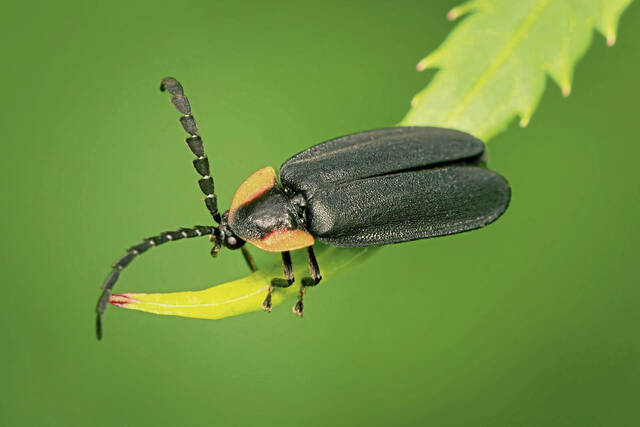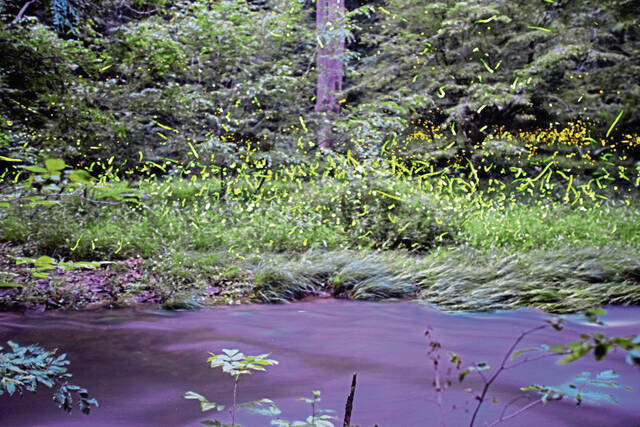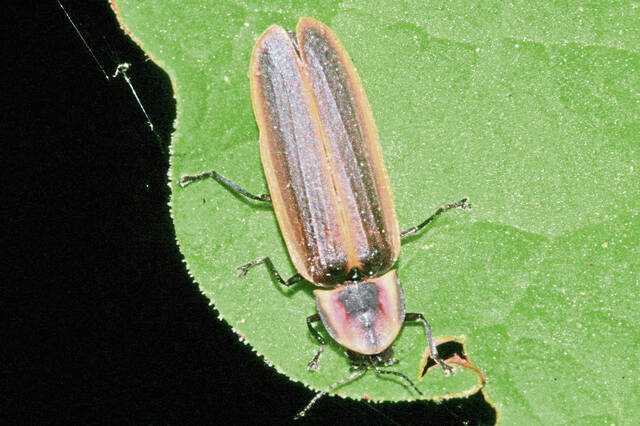Fireflies are making a noticeable return to Western Pa.
The flickering fields of summer nights are back.
Fireflies, it seems, are abundant again.
Throughout the region, people are noticing more of the largely nocturnal, flashing insects. Once a staple of summer evenings, lightning bugs had seemed to become scarce over the past few years thanks to a loss of habitat and the threat of pesticides.
“Right now, I am getting a lot of positive reports from lots of different places, including Pennsylvania,” said Massachusetts-based biologist Richard Joyce. “We also get a lot of reports from all over (the country) saying that they do not see the number that they used to, or (that they) used to see them in a place where they are no longer present.”
Joyce works as an endangered species conservation biologist with the Xerces Society for Invertebrate Conservation and is coordinator of The Firefly Atlas, launched in 2022. The group studies fireflies and works to identify threats to their populations.
Fireflies live in leaves, wild grasses and wet areas, and they like warm, humid nights with still air. Thirty species of fireflies call Pennsylvania home.
Given the rainfall this spring and early summer, perhaps their noticeable flashing yellow presence should come as no surprise.
The light show was impressive at the 13th Annual Pennsylvania Firefly Festival at Kellettville Campground in the Allegheny National Forest, according to Peggy Butler, the festival’s co-founder.
“The weather was much more conducive,” she said. “We had a nice wet spring and an early summer that provided the moisture the fireflies needed.”
While moisture and temperature are known to affect the firefly, not much else is known about them — at least not when compared with other native wildlife.
“If you look at lightning bugs, we are decades behind in terms of the number of people who are paying attention and who are able to identify these species,” Joyce said.
Although there is a shortage of systematic monitoring, there are anecdotal reports from across the country, which the Firefly Atlas processes. These reports consist of people completing a survey, catching lightning bugs, taking flash pattern notes, collecting information about the habitat and logging it all into a data portal that maps where each species can be found.
According to the group, one species of firefly is considered threatened in Pennsylvania.
Joyce has received mixed messages this year, but news reports out of the Northeast suggest a firefly resurgence. A Weather Channel report mentioned reports from the Allegheny National Forest, Cuyahoga Valley National Park near Cleveland and the Catskill Mountains in New York.
Carya Cornell, a naturalist educator with the Pittsburgh Parks Conservancy, said firefly populations are fairly steady in Western Pennsylvania.
“There are species being threatened or endangered, but those in Western Pa. are not necessarily a concern,” they said.
Deaglan McManus, senior park ranger at Deer Lakes, Harrison Hills, Hartwood Acres and North Park, said fireflies are noticeable in all nine Allegheny County Parks.
“We have observed healthy populations of fireflies at the South Park meadow, Boyce Park Celebration Meadow, the Caren Glotfelty Meadow in Hartwood Acres and at Deer Lakes Park,” McManus said.
Loss of habitat
Butler said 14% of fireflies in North America are endangered because of habitat loss. Experts do not have enough information for 53% of firefly species to determine their status.
Some firefly species are adaptable, Joyce said, and can be found in urban environments.
“When people ask me how are fireflies doing or how are their trends, my follow-up question is, ‘which species are you talking about?’ because that often gets lost in the conversation,” he said.
Tidying yards and manicuring lawns may make for strong curb appeal, but it isn’t ideal for fireflies.
“If someone is removing all of the leaves on their properties, cutting down forests to make lawns or removing farms to make subdivisions, that is taking habitat away from the lightning bugs,” Cornell said.
Pesticides used on lawns to control white grubs, or baby beetles, also will have an impact on fireflies, Joyce said.
“Fireflies are also beetles, so ultimately, they will be affected,” he said.
The Allegheny County Parks Department has been working to restore firefly habitats.
Since 2017, it has turned more than 53 acres of mowed grasslands into native meadows at Deer Lakes Park, Boyce Park, South Park, Hartwood Acres Park, North Park and White Oak Park, McManus said.
“We have also planted over 21,000 trees across our nine parks since 2016, over 4,000 of which were lawn-to-forest projects where mowed turf grass was replaced with trees,” McManus said.
Light pollution
Elliot Smith, young naturalist crew leader with the Pittsburgh Parks Conservancy, said light pollution affects all organisms, especially fireflies.
“The excess light from streetlights, businesses and other kinds of artificial light can (interrupt) the communication between lightning bugs,” Smith said.
He explained that females will flash to attract males to mate. If they cannot see each other, their ability to reproduce will be affected.
Light pollution also impacts an organism’s circadian rhythm, which influences sleep, appetite, hormones and other important functions of survival, Smith said.
“Any amount of excess light at night, especially elevated levels which can be found in cities, can have a major negative impact on organisms, and fireflies especially,” he said.
To decrease light pollution, Pittsburgh’s Department of Mobility & Infrastructure and The Efficiency Network began an LED streetlight modernization project in June.
It’s too soon to tell if the project is having an impact, said Flore Marion, assistant director of the sustainability and resilience division of the city’s planning department.
Madison Stokes is a Tribune-Review staff writer. You can contact Madison at mstokes@triblive.com.
Remove the ads from your TribLIVE reading experience but still support the journalists who create the content with TribLIVE Ad-Free.



